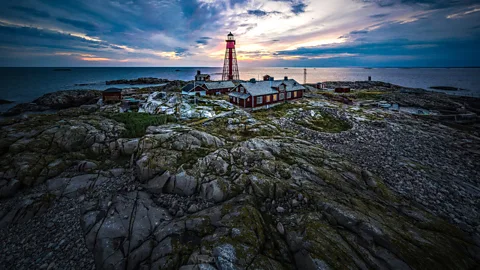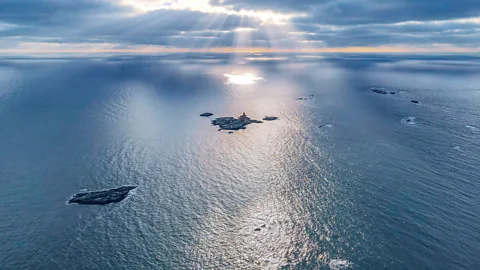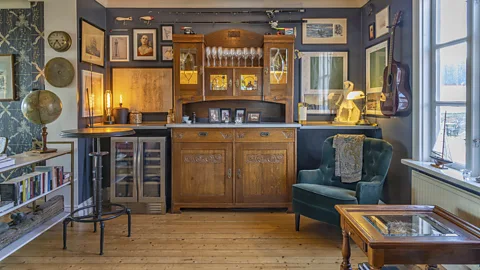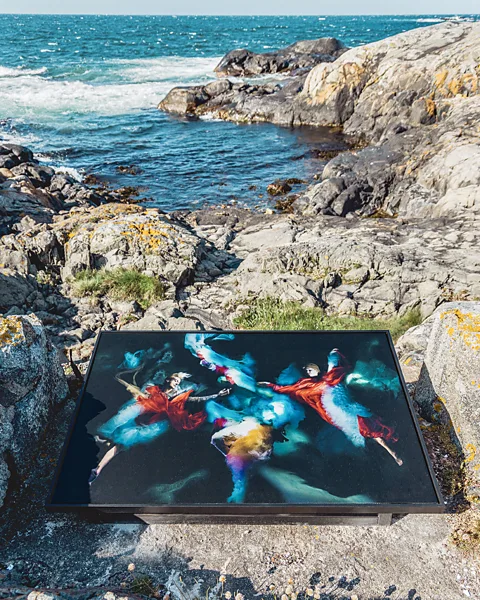Pater Noster: The luxury hotel on an isolated, inhospitable isle
 Erik Nissen Johansen
Erik Nissen JohansenOnce a place to warn sailors of perils off Sweden's west coast, Pater Noster now welcomes travellers looking for an alternative to modern life.
Waves turned our boat into a bucking bronco on the journey to Hamneskär, an island 8km off Sweden's west coast, an hour or so from Gothenburg. It was a neat reminder about the power of the sea and the reason for the island's tomato-red, 36m-tall Pater Noster lighthouse.
In the last 1,000 years, at least 700 ships are known to have sunk on these reefs; the lighthouse's name (Latin for "Our Father") comes from its position in a chain of islands that look like beads on a rosary, or, as some say, the prayer uttered by terrified sailors passing through these parts. From the top of the lighthouse, wrecks are still visible among the 200 islands, skerries and low-lying seal-slung rocks.
Safely in the harbour, I discovered a different scene entirely. The Pater Noster lighthouse, the centrepiece of an island measuring just 150m by 200m, is home to an award-winning, nine-room hotel retreat that honours its history while providing a luxurious escape from modern life.
"In 30 years' time, 95% of the world's population will live in big cities," said Erik Nissen Johansen, designer and founder of Gothenburg's internationally acclaimed hospitality design agency Stylt Trampoli, and one of the team behind the hotel. "If you want a vacation that makes sense, you need a contrast to your everyday life. Different is the currency."
 Erik Nissen Johansen
Erik Nissen JohansenThe hotel (total capacity 24 guests), a series of 19th-Century red-painted wooden buildings in the island's centre, certainly offers that. The three small houses were once home to lighthouse keepers and their families; there is also a boatshed, now a dining room and kitchen, and an old food storage vault with metres-thick walls that now functions beautifully as a wine cellar.
How to visit:
When to go: Peak travel season in the Gothenburg archipelago is June-July; for a quieter stay, go off peak.
How to get there: From Gothenburg, take a bus to Marstrand. The RIB to the island takes 15 minutes from Marstrand ferry port.
What to do: Relax, take in the sea air, take a tour of the island, swim, sauna and read. Previous guests have brought creative projects to complete in the quiet hut overlooking the old harbour. Fishing trips and kayak tours are also available.
What to eat: Pater Noster is a full-board hotel. Expect a superlative Swedish breakfast and a dinner of gourmet seaweed, lobsters and local fish.
Away from this mini hub, a sauna house gently simmers atop the rocks, two hot tubs stand on the cliff and a narrow path leads to a vegetable garden. Overlooking it all, the metal skeleton of the lighthouse looms large. It is still a beacon for the sailboats and tankers that skim the horizon but, decommissioned in 1977, it no longer serves an official function. That purpose is served by the modern lighthouse that's built into the seabed 3,500m away in the channel.
A stay here is something quite remarkable. It's a tiny island but it holds so much: my guided tour of the island – given to all guests – took me past the modern sauna and along the rocky coastline to the original flower and vegetable garden used by the first lighthouse keepers. It's all part of the experience here, which, at 15,000 SEK (£1,150) per night, is full board and all-inclusive of transport, activities and food.
Wine and oysters are enjoyed in the wine cellar, stories are told over a seaweed and seafood dinner, and much is focused on that blue space between the island and the horizon in order to educate guests about how to better treat the ocean.
It's a story that they walk as well as talk: furniture and decor was sourced second-hand in local spots to underline the cultural history story, and the hotel works with scientists to monitor lobster populations and tuna migrations.
 Erik Nissen Johansen
Erik Nissen JohansenTurning the historical cottages into a profitable hotel wasn't easy. The buildings had housed small-scale hotels before, but they hadn't proved sustainable, and the island had passed from hand to hand until Johansen saw the opportunity. Bringing together an eclectic group of ocean-loving partners, including a restaurateur and the owner of a boat charter firm, he set out to create something different.
"We asked ourselves: what is luxury?" he said. "Everybody felt that this was one part of the answer: an isolated island far away from everything in raw nature."
Opening at the start of the pandemic, the isolated hotel struck a chord. Within weeks they were featured in glossy magazines around the world, and a call came from the 2021 Oscars team, asking to include a stay in its gift bag.
Not long after the Oscars nod, the Pater Noster team saw an opportunity to collaborate with the Gothenburg Film Festival in 2021, which that year had a theme of solitude and was forced to show its films in restricted cinemas thanks to the pandemic. In conjunction with the festival, they ran a competition offering a week-long stay on the island to watch the film festival's entries in a room at the top of the lighthouse. Thirteen thousand people from 46 countries applied; the winner was Lisa Enroth, a Swedish nurse who worked in Covid wards during the pandemic.
 Erik Nissen Johansen
Erik Nissen Johansen"We wanted to dial into culture because we see what happens when we do that," said Johansen. "There is a theory called the 'Five Stages of Luxury', which goes from having possessions to craving poetic experiences. That last category is increasing – people who are experience-seekers are looking for that."
Poetic details are everywhere, from black-and-white photos of the original lighthouse families on the walls to the open-air bed on the clifftop, a prime sunset-watching spot. Pater Noster's CEO, Mirja Lilja Hagsjö, showed me around the garden and pointed out the rhubarb, herbs and sweet peas. For her, it is this combination of history and setting that makes the experience so special.
"The island gives you a lot – you just need to see it," she said. She has created, among other things, a meditation for those swimming in the sea around the island, encouraging swimmers to take a moment to see how the seaweed waves in the water and to fully experience all their senses. "Don't just go in and out," she advised, "there's more to it than that."
 Christy Lee Rogers
Christy Lee RogersThis interaction with the ocean is a key takeaway for all the hotel's guests. One of its missions is to make sure that guests leave with more knowledge about the ocean than when they arrive, something that manifests in piles of coffee table books about the sea, sea life and Sweden, a glorious art trail around the island showing the underwater photography of Christy Lee Rogers and Zena Holloway, and a series of delicious seaweed amuse bouches as part of guests' four-course seafood dinner.
Carbon Count
The travel emissions it took to report this story were 0.03 metric tons of CO2e. Find out more about how we calculated this figure here.
In better weather and during a longer stay, I could have taken a kayak tour of the rocky inlets and local seal sanctuary, just visible offshore, gone seaweed harvesting or mackerel fishing.
I swam in the morning, slipping into the water from the rocks, and felt the fronds of seaweed caress me, connecting me to the water, the waves, the rocks and the island. It was a deft way to make a moment last longer, and a tiny place feel so much bigger.
Green Getaways is a BBC Travel series that helps travellers experience a greener, cleaner approach to getting out and seeing the world.
---
Join more than three million BBC Travel fans by liking us on Facebook, or follow us on Twitter and Instagram.
If you liked this story, sign up for The Essential List newsletter – a handpicked selection of features, videos and can't-miss news delivered to your inbox every Friday.
